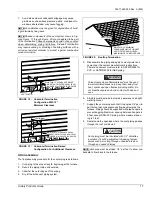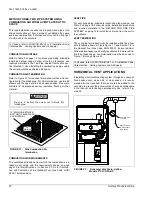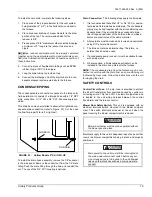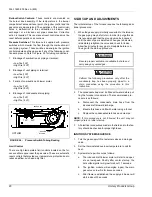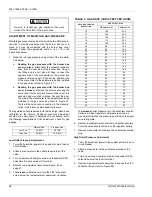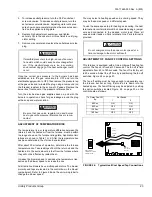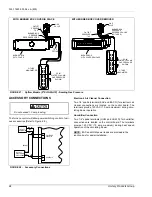
035-17480-000 Rev. A (800)
Unitary Products Group
9
Some utility companies or local codes require pipe sizes
larger than the minimum sizes listed in these instructions and
in the codes. Properly sized wrought iron, approved flexible
or steel pipe must be used when making gas connections to
the unit. The installation of a drop leg and ground union is
required (refer to Figure 5).
Gas piping may be connected from either side of the furnace
using any of the gas pipe entry knockouts on both sides of
the furnace (refer to Figure 1 for locations and dimensions).
NOTE: Plan your combustion air piping before determining
the correct gas pipe entry. Use 90 degree service elbow(s), or
short nipples and conventional 90 degree elbow(s) to enter
through the cabinet access holes.
NOTE: An accessible manual shutoff valve must be installed
upstream of the furnace gas controls and within 6 feet of the
furnace.
NOTE: A 1/8” NPT plug is included in the inlet side of the gas
valve for measuring incoming gas pressure.
The furnace must be isolated from the gas supply piping sys-
tem by closing its individual external manual shutoff valve
during any pressure testing of the gas supply piping system
at pressures equal to or less than 1/2 psig (3.48 kPa).
The furnace and its individual shutoff valve must be discon-
nected from the gas supply piping system during any pres-
sure testing of that system at test pressures in excess of 1/2
psig (3.48 kPa).
ELECTRICAL POWER CONNECTION
Field wiring to the unit must conform to and be grounded in
accordance with the provisions of the National Electrical
Code ANSI/NFPA No. 70-latest edition, Canadian Electric
Code C22.1 Part 1 - (latest edition) and/or local codes. Elec-
tric wires which are field installed shall conform with the tem-
perature limitation for 63°F/35°C rise wire when installed in
accordance with instructions. Refer the rating plate or Physi-
cal and Rating Data Tables in these instructions for specific
furnace electrical data.
Provide a power supply separate from all other circuits. Install
overcurrent protection and disconnect switch per local/
national electrical codes. The switch should be close to the
unit for convenience in servicing. With the disconnect switch
in the OFF position, check all wiring against the unit wiring
label. Also, see the wiring diagram in this instruction.
An overpressure protection device, such as a
pressure regulator, which conforms to the National
Fuel Gas Code, ANSI Z223.1 (U.S.) or CAN-
B149.1 or.2 (Canada) and acts to limit the down-
stream pressure to a value that does not exceed
0.5 PSI (14" w.c.), must be installed in the gas pip-
ing system upstream of the furnace. Failure to do
so may result in a fire or explosion or cause dam-
age to the furnace or some of its components.
INLET GAS PRESSURE RANGE
Natural Gas
Propane (LP)
Minimum
4.5 In. W.C.
11 In. W.C.
Maximum
13.9 In. W.C.
13.9 In. W.C.
FIGURE 5 :
Gas Piping
G A S V A L V E
D R O P L E G
G R O U N D J O I N T U N I O N
M A Y B E I N S T A L L E D
I N S I D E O R O U T S I D E U N I T
T O G A S
S U P P L Y
E X T E R N A L M A N U A L
S H U T O F F V A L V E
T O G A S
S U P P L Y
D R O P L E G
Compounds used on threaded joints of gas piping
must be resistant to the action of liquefied petro-
leum gases. After connections are made, leak-test
all pipe connections.
After all gas piping connections are completed,
leak test all joints, fittings and furnace connections
with rich soap and water solution, commercially
available bubble type leak detection fluid, or other
approved means.
Do not use an open flame or other source of
ignition for leak testing.
Never apply a pipe wrench to the body of the com-
bination automatic gas valve. A wrench must be
placed on the projection or wrench boss of the
valve when installing piping to it.

















